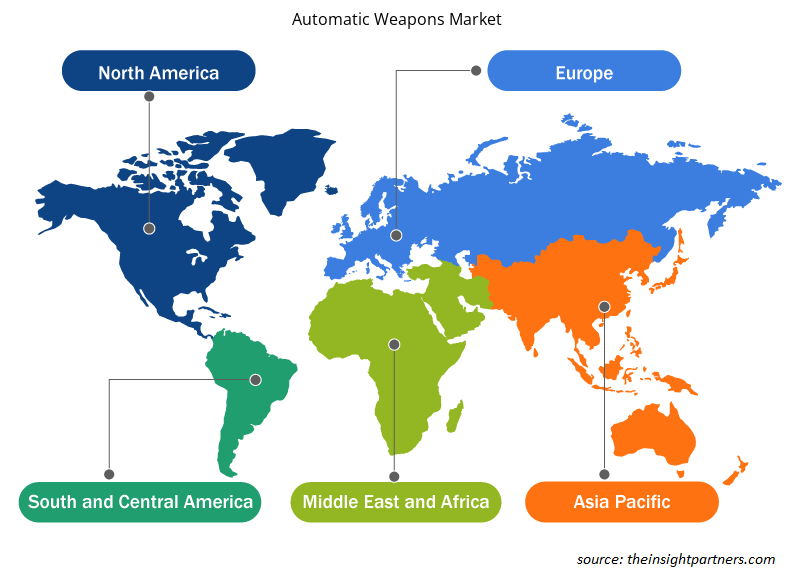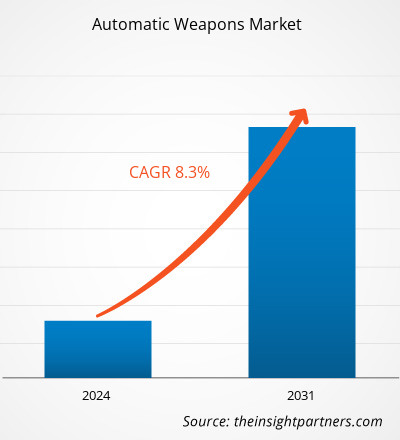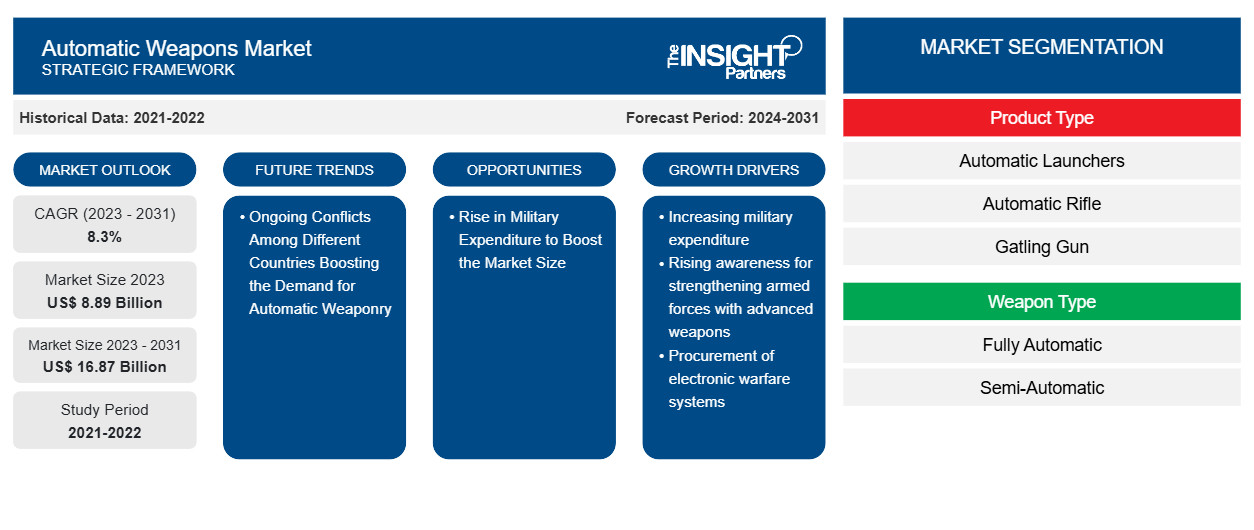Si prevede che il mercato delle armi automatiche raggiungerà i 16,87 miliardi di dollari entro il 2031, rispetto agli 8,89 miliardi di dollari del 2023. Si prevede che il mercato registrerà un CAGR dell'8,3% nel 2023-2031.
Il volto del combattimento cambia costantemente nello scenario attuale. Ciò è dovuto principalmente ai cambiamenti nelle moderne tecnologie di guerra. Le forze militari in tutto il mondo sono alla continua ricerca di tecnologie avanzate per impedire ai loro nemici di oltrepassare i confini. Inoltre, varie forze militari stanno acquisendo armi tecnologicamente robuste per migliorare le capacità dei soldati. La tendenza alla modernizzazione dei soldati sta rapidamente aumentando tra diverse forze di difesa nei paesi sviluppati e nelle nazioni in via di sviluppo in tutto il mondo. Lo sviluppo di armi moderne svolge un ruolo fondamentale nelle attività di modernizzazione dei soldati. La domanda di armi avanzate è cresciuta positivamente tra le forze di difesa nel corso degli anni e negli ultimi anni l'approvvigionamento di armi automatiche è aumentato esponenzialmente. L'elevata domanda di armi automatiche ha portato diverse aziende affermate ad avventurarsi nel segmento di mercato e anche numerose aziende di livello 2 a produrre armi automatiche. Un numero enorme di produttori presenti sul mercato facilita le forze di difesa nell'assegnare contratti ai produttori più preferiti.
Analisi del mercato delle armi automatiche
L'industria della difesa globale sta mostrando una crescita straordinaria in termini di spese, investimenti in ricerca e sviluppo, approvvigionamenti di armamenti e anche modernizzazione dei soldati. La continua crescita della domanda di armamenti avanzati, artiglierie e altri equipaggiamenti e materiali per la difesa sta consentendo all'industria manifatturiera di prodotti per la difesa di assistere a un aumento del numero di produttori nel corso degli anni. L'industria manifatturiera di armi è fortemente concentrata e la crescita del settore è costantemente costante. Negli ultimi anni, la domanda di armi automatiche è cresciuta in modo esponenziale, a causa dei vantaggi dell'arma tecnologicamente avanzata. A causa della crescente domanda, il settore manifatturiero di armi automatiche sta anche sperimentando una crescita nella concentrazione di produttori e fornitori. Nello scenario attuale, il potere contrattuale dei fornitori è in moderata crescita, attribuito all'elevato grado di competizione per acquisire contratti dalle forze di difesa. Tuttavia, si prevede che il potere contrattuale dei fornitori salirà a un livello più elevato nei prossimi anni, a causa dell'aumento dell'approvvigionamento di armi automatiche tra le forze di difesa nei paesi in via di sviluppo.
Panoramica del mercato delle armi automatiche
È probabile che il mercato delle armi automatiche assista a una forte crescita nel periodo 2023-2031. La domanda per il mercato delle armi automatiche è guidata principalmente da alcuni fattori chiave quali:
- Aumento delle spese militari
- Crescente consapevolezza per il rafforzamento delle forze armate con armi avanzate
- Acquisto di sistemi di guerra elettronica
- Tensioni geopolitiche in corso tra diversi paesi
È probabile che tali fattori determinino la crescita del mercato delle armi automatiche nei prossimi anni.
Personalizza questo report in base alle tue esigenze
Riceverai la personalizzazione gratuita di qualsiasi report, comprese parti di questo report, o analisi a livello nazionale, pacchetto dati Excel, oltre a usufruire di grandi offerte e sconti per start-up e università
-
Scopri le principali tendenze di mercato in questo rapporto.Questo campione GRATUITO includerà analisi di dati che spaziano dalle tendenze di mercato alle stime e alle previsioni.
Driver e opportunità del mercato delle armi automatiche
Aumento del numero di contratti per armi automatiche
Il crescente numero di contratti per armi automatiche sta guidando la crescita del mercato delle armi automatiche. Ad esempio:
- Nell'aprile 2022, l'esercito americano ha assegnato un contratto decennale alla Sig Sauer Inc. per la produzione e la consegna di due varianti dell'arma di squadra di nuova generazione (il fucile XM5 e il fucile automatico XM250) e della famiglia di munizioni 6.8 Common Cartridge.
- Nel settembre 2023, il Ministero della Difesa degli Stati Uniti ha assegnato un contratto a DE&S per la fornitura di un sistema di armi alternative individuali (AIW), noto come L403A1, del valore di 111 milioni di dollari.
Aumento della spesa militare per aumentare le dimensioni del mercato
L'aumento della spesa militare in diversi paesi probabilmente genererà nuove opportunità per i venditori di mercato nei prossimi anni. Ad esempio, secondo i dati SIPRI, la spesa militare globale nel 2020 è stata di circa 2046,5 miliardi di dollari USA; 2069,76 miliardi di dollari USA nel 2021; e 2148,12 miliardi di dollari USA nel 2022 rispettivamente. Ciò mostra una crescita negli investimenti delle forze militari in tutto il mondo che stanno costantemente acquistando diverse tecnologie militari per aggiornare la rispettiva flotta di armi.
Analisi della segmentazione del rapporto di mercato sulle armi automatiche
I segmenti chiave che hanno contribuito alla derivazione dell'analisi del mercato delle armi automatiche sono il tipo di prodotto, il tipo di arma, l'applicazione e la geografia.
Applicazione (terrestre, aerea e navale)
- In base al tipo di prodotto, il mercato delle armi automatiche è stato segmentato in lanciatori automatici, fucili automatici, mitragliatrici Gatling, mitragliatrici e cannoni automatici. Il segmento dei fucili automatici ha detenuto una quota di mercato maggiore nel 2023.
- In base al tipo di arma, il mercato è stato segmentato in completamente automatico e semi-automatico. Il segmento completamente automatico ha detenuto la quota maggiore del mercato nel 2023.
- In termini di applicazione, il mercato è stato segmentato in terrestre, aereo e navale. Il segmento terrestre ha dominato il mercato nel 2023.
Analisi della quota di mercato delle armi automatiche per area geografica
L'ambito geografico del rapporto sul mercato delle armi automatiche è suddiviso principalmente in cinque regioni: Nord America, Europa, Asia Pacifico, Medio Oriente e Africa e Sud America.
Nel 2023, la regione del Nord America ha dominato il mercato globale delle armi automatiche e si prevede che manterrà il suo predominio anche durante il periodo di previsione. Ciò è dovuto principalmente alla presenza del paese con la maggiore spesa militare, ovvero gli Stati Uniti, e alla presenza di alcuni dei principali produttori di armi automatiche nella regione, tra cui Northrop Grumman Corporation, Armalite Inc, Colts Manufacturing Company LLC, Barrett Firearms Manufacturing e General Dynamics Ordnance & Tactical Systems, che supportano costantemente le richieste dell'esercito statunitense e delle forze armate internazionali. Si prevede che la presenza di un numero significativamente elevato di attori nella regione stimolerà la crescita del mercato.
Notizie e sviluppi recenti sul mercato delle armi automatiche
Il mercato delle armi automatiche viene valutato raccogliendo dati qualitativi e quantitativi dopo la ricerca primaria e secondaria, che include importanti pubblicazioni aziendali, dati associativi e database. Di seguito è riportato un elenco degli sviluppi nel mercato delle armi automatiche e delle strategie:
- Nel febbraio 2024, il Ministero della Difesa ha annunciato di essere in procinto di aggiudicare un contratto, del valore di 49,5 milioni di dollari USA, a FNH UK Ltd per il Mid Life Improvement (MLI) delle mitragliatrici pesanti (HMG) in servizio presso i comandi delle forze armate del Regno Unito. (Fonte: Ministero della Difesa del Regno Unito, comunicato stampa/sito Web aziendale/newsletter)
- Ad aprile 2022, l'esercito ha recentemente assegnato un contratto al produttore SIG Sauer per due nuove armi per i soldati: il fucile XM5 e il fucile automatico XM250. Per i soldati coinvolti nel combattimento ravvicinato, l'XM5 ha sostituito il fucile carabina M4/M4A1, mentre l'XM250 ha sostituito l'arma automatica di squadra M249. (Fonte: Dipartimento della Difesa degli Stati Uniti, comunicato stampa/sito Web aziendale/newsletter)
Approfondimenti regionali sul mercato delle armi automatiche
Le tendenze regionali e i fattori che influenzano il mercato delle armi automatiche durante il periodo di previsione sono stati ampiamente spiegati dagli analisti di Insight Partners. Questa sezione discute anche i segmenti e la geografia del mercato delle armi automatiche in Nord America, Europa, Asia Pacifico, Medio Oriente e Africa e Sud e Centro America.

- Ottieni i dati specifici regionali per il mercato delle armi automatiche
Ambito del rapporto sul mercato delle armi automatiche
| Attributo del report | Dettagli |
|---|---|
| Dimensioni del mercato nel 2023 | 8,89 miliardi di dollari USA |
| Dimensioni del mercato entro il 2031 | 16,87 miliardi di dollari USA |
| CAGR globale (2023-2031) | 8,3% |
| Dati storici | 2021-2022 |
| Periodo di previsione | 2024-2031 |
| Segmenti coperti |
Per tipo di prodotto
|
| Regioni e Paesi coperti |
America del Nord
|
| Leader di mercato e profili aziendali chiave |
|
Densità degli attori del mercato delle armi automatiche: comprendere il suo impatto sulle dinamiche aziendali
Il mercato delle armi automatiche sta crescendo rapidamente, spinto dalla crescente domanda degli utenti finali dovuta a fattori quali l'evoluzione delle preferenze dei consumatori, i progressi tecnologici e una maggiore consapevolezza dei vantaggi del prodotto. Con l'aumento della domanda, le aziende stanno ampliando le loro offerte, innovando per soddisfare le esigenze dei consumatori e capitalizzando sulle tendenze emergenti, il che alimenta ulteriormente la crescita del mercato.
La densità degli operatori di mercato si riferisce alla distribuzione di aziende o società che operano in un particolare mercato o settore. Indica quanti concorrenti (operatori di mercato) sono presenti in un dato spazio di mercato in relazione alle sue dimensioni o al valore di mercato totale.
Le principali aziende che operano nel mercato delle armi automatiche sono:
- Armalite Inc
- Produzione di armi da fuoco Barrett
- Azienda manifatturiera Colts LLC
- Fabbrica d'Armi Pietro Beretta SPA
- FN America LLC
- Dinamica generale OTS
Disclaimer : le aziende elencate sopra non sono classificate secondo un ordine particolare.

- Ottieni una panoramica dei principali attori del mercato delle armi automatiche
Copertura e risultati del rapporto sul mercato delle armi automatiche
Il rapporto "Dimensioni e previsioni del mercato delle armi automatiche (2021-2031)" fornisce un'analisi dettagliata del mercato che copre le seguenti aree:
- Dimensioni e previsioni del mercato a livello globale, regionale e nazionale per tutti i segmenti di mercato chiave coperti dall'ambito
- Dinamiche di mercato come fattori trainanti, vincoli e opportunità chiave
- Principali tendenze future
- Analisi dettagliata delle cinque forze di Porter
- Analisi di mercato globale e regionale che copre le principali tendenze di mercato, i principali attori, le normative e gli sviluppi recenti del mercato
- Analisi del panorama industriale e della concorrenza che copre la concentrazione del mercato, l'analisi della mappa di calore, i principali attori e gli sviluppi recenti
- Profili aziendali dettagliati con analisi SWOT
- Analisi storica (2 anni), anno base, previsione (7 anni) con CAGR
- Analisi PEST e SWOT
- Valore/volume delle dimensioni del mercato - Globale, Regionale, Nazionale
- Industria e panorama competitivo
- Set di dati Excel
Report recenti
Testimonianze
Motivo dell'acquisto
- Processo decisionale informato
- Comprensione delle dinamiche di mercato
- Analisi competitiva
- Analisi dei clienti
- Previsioni di mercato
- Mitigazione del rischio
- Pianificazione strategica
- Giustificazione degli investimenti
- Identificazione dei mercati emergenti
- Miglioramento delle strategie di marketing
- Aumento dell'efficienza operativa
- Allineamento alle tendenze normative























 Ottieni un campione gratuito per - Mercato delle armi automatiche
Ottieni un campione gratuito per - Mercato delle armi automatiche